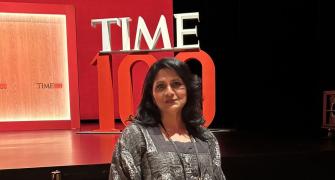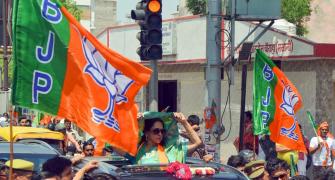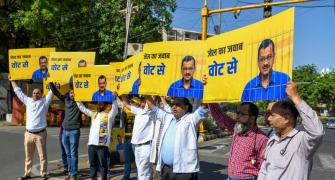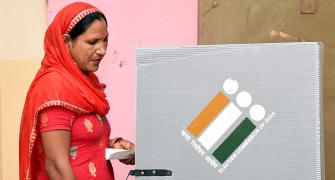As an avid James Bond fan, I'm willing to go along with the view that the government legitimising Reliance Infocomm's CDMA-mobile phone offerings on its fixed line licence in 2002 was not a grand conspiracy, but was 'happenstance', as Auric Goldfinger would have said.
Sure, it helped Reliance move from being a virtual nobody in the telecom space to a contender for the second or third spot, but it was a one-shot affair. Once the BJP's Arun Shourie did Reliance this good deed, the feeling was, it would compete with the rest on a level playing field.
Extending Goldfinger's logic, Telecom Minister A Raja's decision to treat Reliance Communications' (as it is now known) CDMA-licence as a GSM-mobile one last year and to award it GSM spectrum, is a 'coincidence'.
Of course, what's ironical is that the other firms who were part of this decision - Reliance's entry into the GSM space was part of a plan to bring in more players - haven't been allocated spectrum while Reliance has.
Indeed, Raja has made such a mess of things that the others who thought they would get a great bargain (by paying Rs 1,651 crore (Rs 16.51 billion) for spectrum worth at least three times more) are not sure exactly when they will be able to cash in, or by how much.
Instead of auctioning spectrum to bring in new players, as is well known, Raja decided he would bring in new players based on the date they applied for licences and, thanks to a wishy-washy Trai recommendation on the matter, created a special queue for Reliance-type CDMA players who now wanted to offer the far more popular GSM-mobile services.
While Reliance was allowed to deposit its licence fee before an official announcement of the new policy was made, Raja's ministry then opened up the door at an hour's notice, telling players that their position in the line for spectrum -- a licence without spectrum is useless -- would depend upon the date/time on which they made their payment!
While most protested, Raja was able to go ahead since the prime minister decided a confrontation with the politically important DMK's man could cost him his government.
Sadly for Raja, however, some of the aggrieved parties went to the courts, the TDSAT and the Delhi High Court. Idea and Spice argued that while they were at the top of the line in terms of its application for a licence (they had applied in June and August 2006), they were no longer at the top of the queue under the new criterion.
The courts ruled that the ministry had to preserve the seniority based on the applications. As a result, the ministry now dare not allot spectrum to anyone except Reliance, whose spectrum has already been allotted.
A total of over Rs 10,000 crore (Rs 100 billion) has been paid by nine companies for their licences but they will have to wait till there is enough for all of them till even one of them gets spectrum.
Also, given the availability of spectrum, it's unlikely many of the new players will get more than 4.4 MHz, an amount that's not enough to give them a serious market presence.
Which is why, despite Trai ruling out sale of licences for a few years, the ministry has decided it will allow them. (In sharp contrast, while 3G spectrum is to be auctioned, unlike the current case where it is being offered at fixed bargain-basement prices, the government has already announced no M&As will be allowed for five years - the date of the auction, interestingly, is not even known as yet!)
Not content with being the only newcomer to be allotted spectrum, Reliance has now played its third trump card, what Auric would call 'enemy action'. It has asked the government to change the spectrum being allotted to it to a more efficient one!
But first, a brief history of spectrum. Technically, the lower the frequency, the greater the reach. FM radio broadcasts at 98.4 MHz reach a lot of people with a fairly low number of transmission towers. So, the initial frequencies allotted for mobile phones were in the 800/900 MHz frequency - in this band, 25 MHz was kept for the GSM lot and 20 MHz for the CDMA lot.
Globally, around 35 MHz is reserved for GSM in this frequency - in India, 10MHz of this, called the extended-GSM band, from 880-890 MHz, was reserved for CDMA even though GSM phones work on this frequency.
Later, as the GSM frequency got used up, all new allocations to firms like Airtel and Vodafone were made in the 1,800 MHz frequency, which requires roughly double the capital costs in terms of extra transmission towers and related equipment.
Reliance too has been allotted this frequency now. In January, however, the firm asked the ministry to allow it to use the 880-890 MHz band, reserved for CDMA today, for its GSM services! So, not only does it get GSM spectrum in 2008 at the same price paid by others in 2001, it now wants the most efficient spectrum as well.
You can dismiss Shourie's actions in 2002 as 'happenstance', Raja's in 2007 as 'coincidence', but if this happens, it will truly be 'enemy action'.








